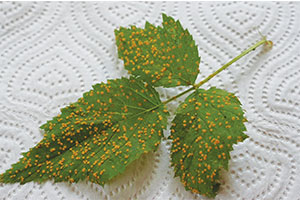Anyone who has raspberries in their garden will come into contact with raspberry yellow rust sooner or later. We are talking about the plant pathogen Phragmidium rubi-idaei, which often appears more at this time of the year, i.e. at the beginning of midsummer. But just how do you identify the symptoms of this disease and how do you get rid of it? Read on for some interesting info from Lubera gardening products…
What is raspberry yellow rust?
Raspberry yellow rust is a fungal disease. More specifically, the fungus belongs to the rusts, which is where it gets its name. An infestation is favoured, as with almost all fungi, by waterlogged soils, humid weather, dense crops and an inadequate hygiene of the plants. Although raspberry yellow rust partially causes a high amount of visual damage, the consequences for the plant are usually less serious than feared. The plant is weakened only in rare cases by a very strong infestation, since it must compulsorily drop its foliage earlier. Then in the following year, due to the lower reserves of the plant, one must expect fewer yields, which is usually not noticeable in the home garden
But how do you recognise raspberry yellow rust?
Symptoms
The first signs of infestation of the fungus can be recognised by spotty, brightened leaf tops. Usually a slightly brown/bronze-coloured surface can be seen on the underside of leaves. When the disease has progressed further, rust-coloured pustules develop on the upper side of the leaves, which are then very clearly visible. By this time at the latest, raspberry yellow rust can be diagnosed with great certainty. In case of heavy infestation, entire canes or even fruits may be infested. By autumn the pustules on the leaves turn black and prepare for the coming winter. 
Life cycle
The biology of raspberry yellow rust is similar to the life cycle of pear rust. The difference is that raspberry yellow rust does not change its host, which is a major advantage for controlling the fungus in the home garden. With pear rust, it is necessary for the fungus to grow on a juniper; without a juniper no pear rust is – fortunately – possible. However, the problem is usually that the needed juniper is in a neighbour’s garden and it scatters the rust fungus...
We will start with the life cycle of raspberry rust during the winter. At this time it is in dormancy, which it spends in so-called permanent spore tufts on the autumn foliage of raspberry plants and matures there. From there, the primary infection takes place at a sufficient temperature, at about 6-7°C, and when there is a sufficient period that the leaves have been wet. If successful, the first symptoms can be seen on the raspberry leaves as described above. From this infection, the fungus now forms so-called conidia. These are spore tufts that can continue to infect the crop throughout the summer, weather permitting. They ensure a rapid spread of spores and thus the fungus. In autumn, before the raspberry loses its leaves, the raspberry rust on the leaves forms the black permanent spore tufts for the winter, making it ready for the next season.
Biological and practical control of raspberry yellow rust
In order to minimise the impact of raspberry yellow rust on your raspberry plants, or even to completely prevent it, there are various possibilities. The first two variants can be read from the life cycle of the fungus. Here the removal of the foliage in autumn/winter is most efficient. As a result, the primary infection in the following year is severely limited or even completely absent – with very clean work. The complete disposal of the leaves is most important here; in the best case, burning the leaves to make the fungus harmless. Another way out of the life cycle is removing the first infested leaves/shoots, which are the primary infection. This can also bring great success because only by the conidia, the secondary infection, large masses of spores are spread. However, you have to control it very carefully and often really get rid of everything early on.
Another way to contain the disease traces back to the trait of many fungal diseases. They need a sufficient period of wetness on the leaves for them to get infected. In order to rob the fungus of this feel-good area in the best possible way, a thin, not too dense plant is advantageous, which can dry quickly. It is important not to keep the amount of canes too dense, i.e. they should be thinned out.
If you do not shy away from the use of copper in your garden (it is also used in organic farming), this is also an option for effective control.
Finally, care should also be taken during fertilisation that there is not too much nitrogen. This makes the plant tissue softer and more susceptible to diseases such as raspberry yellow rust.
The 5 most important ways of getting rid of raspberry rust:
• Remove the leaves in autumn and discard them completely
• Remove the first infested canes and leaves in the vegetation stage
• Keep the plants loose with not too many canes in order to let them dry faster
• Restrained fertilisation that is not too rich in nitrogen
• Treatment with a fungicide, for example with a copper agent
See www.lubera.co.uk for more advice on raspberry rust and other gardening tips.



